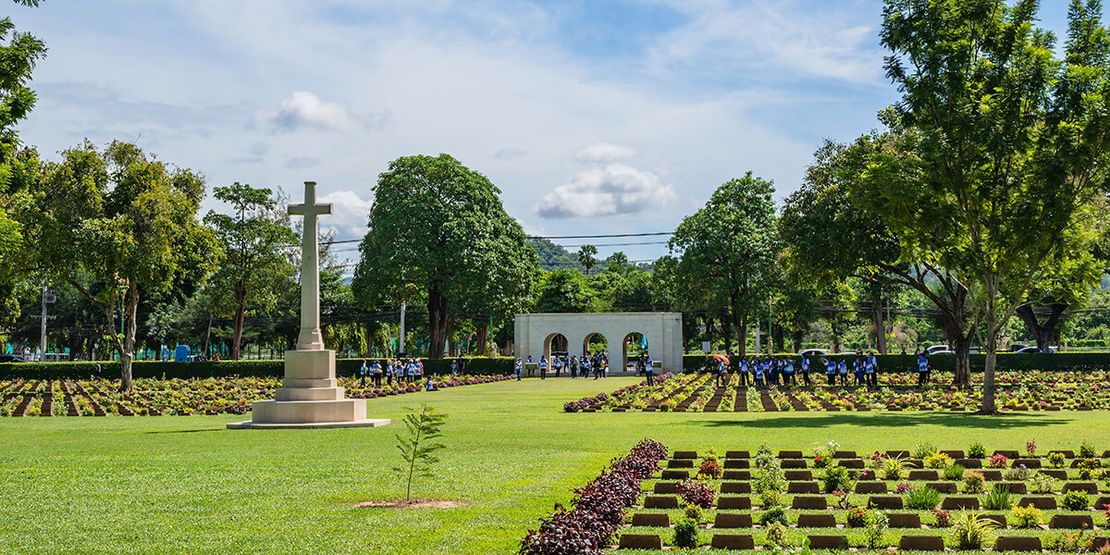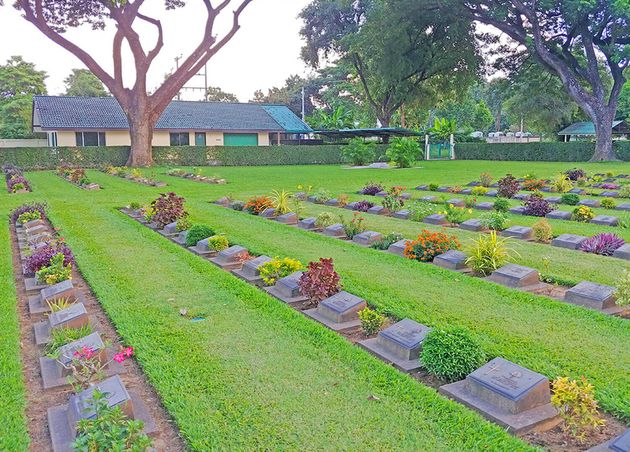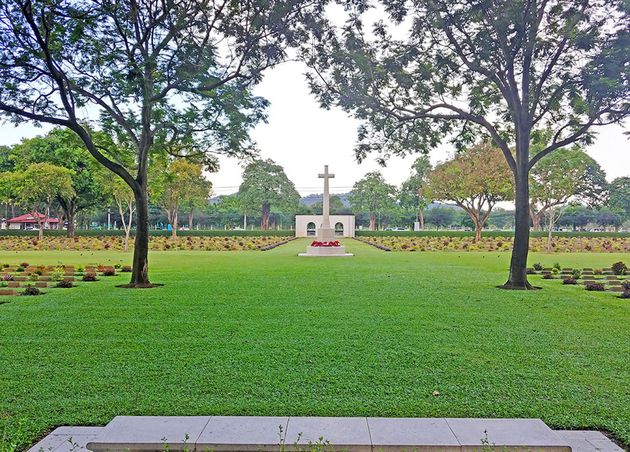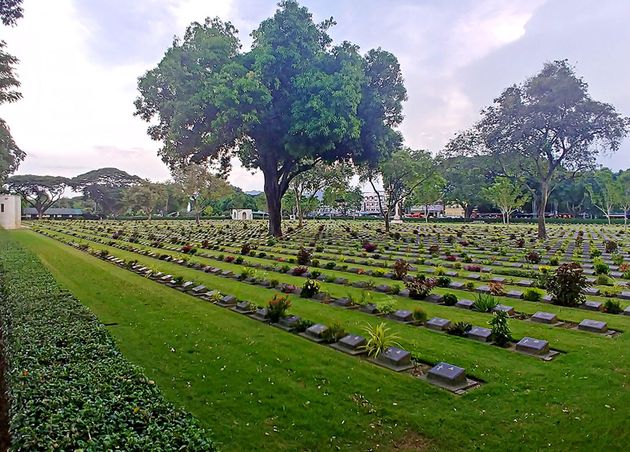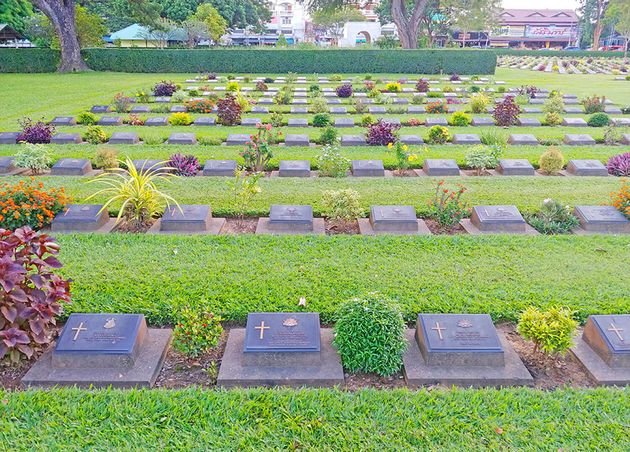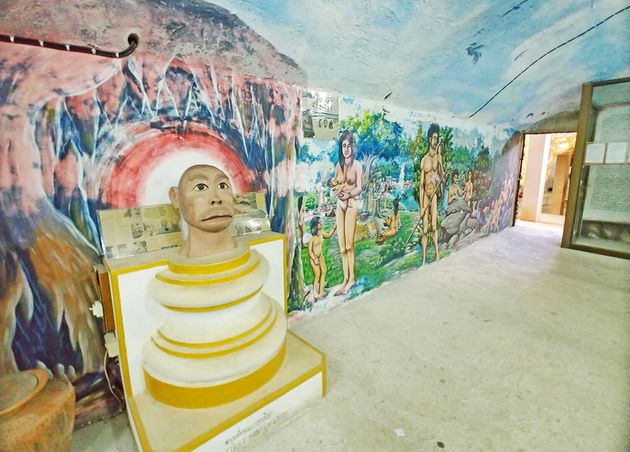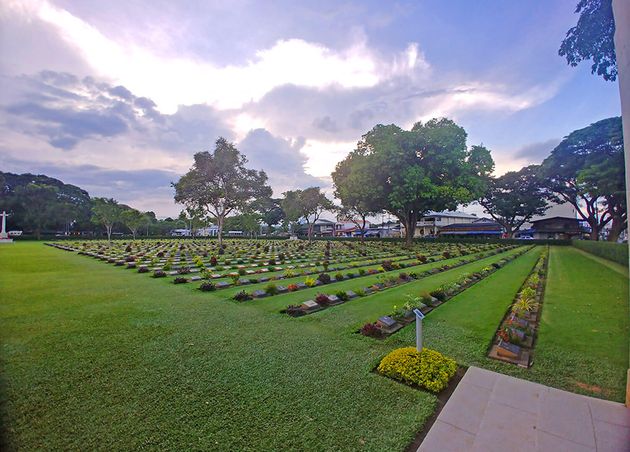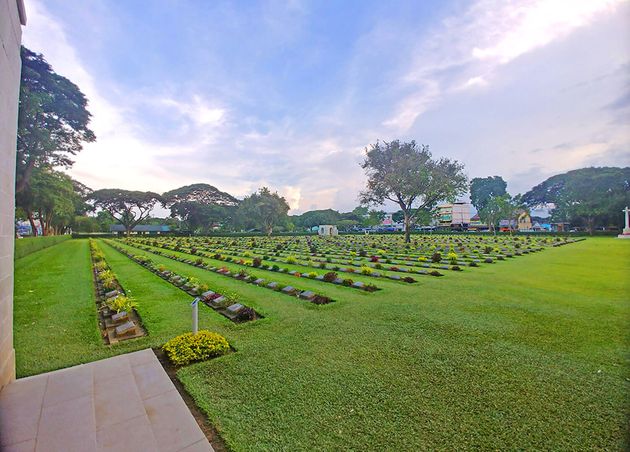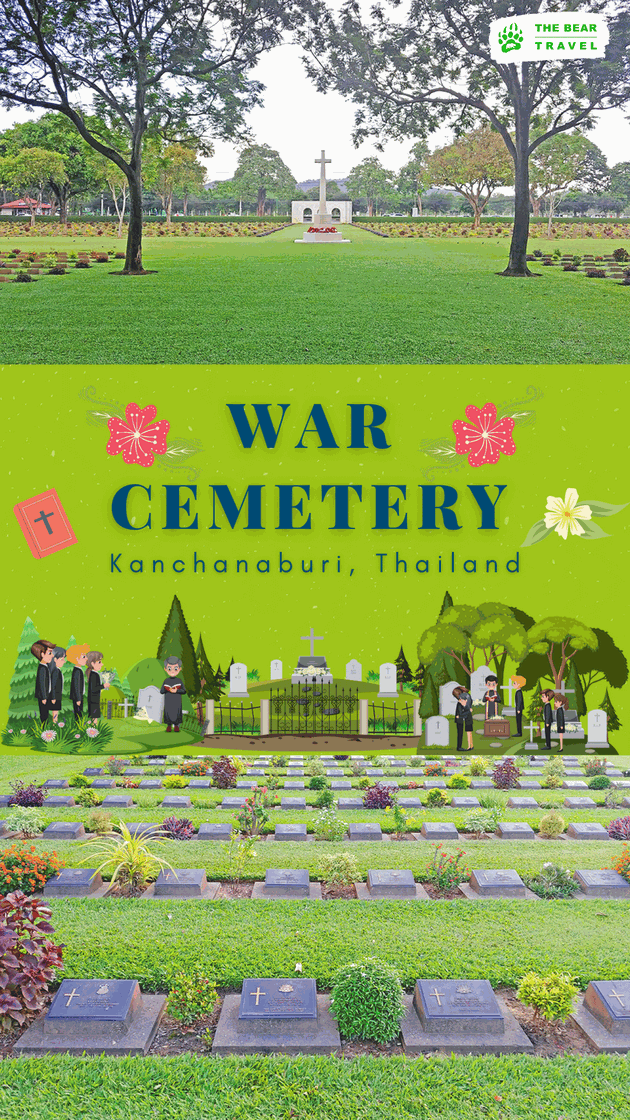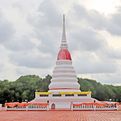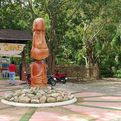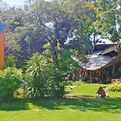Kanchanaburi War Cemetery: A Visit to Remember the Sacrifice and Honor Our Heroes
The province of Kanchanaburi in Thailand is located 130 km away from the city of Krung Thep Maha Nakhon (Bangkok). It is a tourist destination popular with foreigners and Thais looking to escape the craziness of the city. This region is abundant in the stunning scenery and enchanting natural allure, offering a plethora of locations to unwind while exploring its magnificent waterfalls and plentiful hot springs.
The province is also rich in history, especially during World War II. The Japanese came there and built the Death Railway, which took away thousands of innocent lives.
Today you can see the memories of this by going to the many memorials and museums you will see around the area. War Cemetery in Kanchanaburi is one such attraction to learn and experience the feeling of the great war stories of Kanchanaburi.
This captivating region offers a wealth of activities to explore, but without further ado, let's embark on a tour of the Kanchanaburi War Cemetery.
The well-maintained cemetery houses the remains of 6,982 Allied prisoners of war who perished while building the "Death Railway."
A Nostalgic Visit to the War Cemetery
One of the most arousing places to visit in Kanchanaburi is the Don Rak War Cemetery opposite the Kanchanaburi train station. Almost 7,000 POW (Prisoner Of War) graves are laid out straightly amidst the neatly manicured lawns and gardens.
After World War II ended, the cemetery at Don Rak became the final resting place for many who had been forced to endure the brutal conditions imposed by the Japanese army during the construction of Thailand to Burma railway.
Historians calculate that 38 Allied POWs died for each kilometer of track laid on the railway. Those who died were buried at makeshift grave sites along the railway line. After the war ended, Don Rak cemetery was designed as a more fitting resting place and memorial to the fallen, with the soldiers' names, ages, and regiments engraved on the headstones. Where the soldier's identity is unknown, a simple inscription reads, "A soldier who died for his country."
An emotional service of remembrance is held here every year on April 25 (Anzac Day).
A Brief History of Kanchanaburi War Cemetery
The Burma-Siam railway was constructed by prisoners of war from Commonwealth, Dutch, and American forces, at the behest of the Japanese army. The project was aimed at improving communication networks to aid the Japanese military in Burma. During its construction, about 13,000 prisoners of war lost their lives and were buried alongside the railway. Moreover, an estimated 80,000 to 100,000 civilians also died while working on the project. These individuals were forcefully brought from the Dutch East Indies and Malaya or conscripted in Myanmar and Thailand.
The railway was constructed in two sections, with one group of laborers based in Myanmar and the other in Thailand. The Japanese aimed for 14 months to complete the railway, and work began in June 1942. The two groups finally met near Konkoita in October 1943. By December of that year, the railway was fully operational and spanned 424 kilometers. Following the project's completion, the graves of those who lost their lives were transferred from camp burial sites and isolated locations along the railway into three cemeteries in Kanchanaburi and Chungkai in Thailand and Thanbyuzayat in Myanmar.
Kanchanaburi War Cemetery is located in close proximity to the former 'Kanburi,' which served as a prisoner-of-war base camp where most prisoners passed through en route to other camps. The Army Graves Service created the cemetery and transferred all graves along the southern section of the railway from Bangkok to Nieke. The ashes of about 300 individuals who died at the Nike camp were cremated and now rest in two graves within the cemetery. These individuals' names are inscribed on panels located in the shelter pavilion.
The Kanchanaburi War Cemetery serves as the final resting place for 5,085 Commonwealth casualties of World War II, while 1,896 Dutch war graves and one non-war grave are also present. The Kanchanaburi memorial is situated within the entrance building to the cemetery, listing the names of 11 individuals from the Army of Undivided India buried in Muslim cemeteries in Thailand, whose graves could not be maintained.
The Burma-Siam railway project is infamous for its inhumane working conditions and high fatalities during its construction. The prisoners of war and civilians who lost their lives while working on the railway are commemorated at the Kanchanaburi War Cemetery, alongside those who passed away in other camps along the southern section of the railway. The cemetery is a solemn testament to the devastating aftermath of war and its impact on the lives of those undeserving of its violence.
Attractions Around Kanchanaburi War Cemetery
Sai Yok National Park
Home to limestone mountains and cascading waterfalls is the Sai Yok National Park. The 958 square kilometer park has some of the rarest animals in the world. Named after the same waterfall, this beautiful place is known for its numerous sights.
Elephants World Kanchanaburi
Elephants are cute, aren’t they? But sadly, they are an endangered species in many parts of the world. That’s why Elephants' World has decided to protect these animals by giving people a rendezvous with the loving species.
JEATH War Museum and Art Gallery
Experience Thai culture and its rich history and dwell in the wars the nation has fought with the Art Gallery and JEATH War Museum, established by Mr. Aran Chansiri, a jewelry entrepreneur. This private museum houses several exhibits. It was founded in 1995.
The Hellfire Pass Memorial Museum
World War II had caused enormous destruction around the world. And Thailand wasn’t spared as well. One of the areas includes Hellfire Pass. It is the name of a railway cutting on the former Death Railway or Burma Railway. The place was built through forced labor during World War II. It is called Hellfire Pass because of the sight of emaciated prisoners who worked endlessly to construct the pass.
Khao Laem Reservoir
A boat ride on this gigantic reservoir is necessary if you visit Thailand! Formed in the 1980s, when a dam was constructed, the Khao Laem Reservoir is one of the most visited places in the world. The villages here indeed had to be emptied, and now they are submerged, yet the natural beauty of this place is undeniable!
Erawan Waterfall
The Erawan Waterfall is an impressive series of seven waterfalls, each with a profound shape and character. The waterfalls are typically all over the limestone cliffs resulting in colorful pools and shimmering rock formations collaging with the scenery. Over 80% mixed deciduous forest covers the park with big swathes of bamboo. Tigers, elephants, sambar deer, gibbons, and many more animals dwell in these regions. The park also offers visitors to camp among the green landscapes of the fall.
Srinakarin National Park
Srinakarin National Park, established in 1975, is one of the best places for a rendezvous with the wild. The IUCN category II national park is a part of the Kanchanaburi Province and Western Forest Complex Protected area. 1,532 square kilometers is the area of this park. This area is around the Srinakarin Reservoir, formed by the Khwae Yai River.
Why Visit the Kanchanaburi War Cemetery?
The impeccably maintained Kanchanaburi War Cemetery is a solemn reminder of the devastating effects of war. It contains the remains of 6,982 Allied prisoners of war who perished while constructing the "Death Railway."
A visit to the Kanchanaburi War Cemetery is a sincere way to honor the memory of the almost 7,000 casualties of the Second World War, including 5,086 Commonwealth graves and 1,896 Dutch graves, laid to rest in the final resting place designed by Colin St. Clair Oakes.
The cemetery's serene ambiance invites visitors to reflect upon the aftermath of war and the sacrifices made by those who fought for freedom.
How to Visit Kanchanaburi War Cemetery?
Located approximately 129 kilometers North-West of Krung Thep Maha Nakhon (Bangkok), Kanchanaburi is most easily accessible via the National Highway, which runs north from the capital. Visitors can take advantage of the bus and train services available from Bangkok.
Positioned on Saeng Chuto Road, the main thoroughfare through the town, the Kanchanaburi War Cemetery is situated towards the far (northern) end of the town on the left-hand side of the road. Opposite the cemetery is a signpost belonging to the commission that faces it.
The place is a tribute to the men forced to work at the Hellfire place and were prompted to do things even in emaciated conditions.
Map & More Information
The Kanchanaburi War Cemetery, also referred to as the Don-Rak War Cemetery, serves as the primary cemetery for prisoners of war (POWs) who were victims of Japanese imprisonment during the construction of the Burma Railway. It is located on Saeng Chuto Road, the main thoroughfare through Kanchanaburi town in Thailand. Situated next to an older Chinese cemetery, the Kanchanaburi War Cemetery is home to 6,982 graves of POWs from Australia, Britain, and the Netherlands, with 6,858 of those graves having been identified.
|
Business Hours |
08:00 AM - 17:00 PM | Monday - Sunday |
|
Business Address |
284/66 Sangchuto Rd, Ban Tai, Mueang Kanchanaburi District, Kanchanaburi 71000 |
|
GPS |
14.031636, 99.5255602 |
The Bear Team
We, The Bear Team, are a united group of digital experts and adventurers. Combining technical skills with creative flair, we deliver informative, valuable, up-to-date content. Whether seeking travel inspiration or innovative solutions, we're your go-to for fun, authentic, impactful, and timeless experiences.
The Bear Travel | Experience like a Local
A fast-growing Thailand Travel Blog written by Expats and Thais since 2017. We will share our experiences and ideas from an insider point of view for you to create your own unique Thailand experience.
For the latest news and events about The Bear Travel, follow us on Facebook, Instagram, Twitter, Pinterest, or YouTube.
For any issues, concerns, or queries, don’t hesitate to CONTACT us.
Recommended for you
Rayong: A Guide to Visiting the Beauty of the Eastern Seaboard
Dr. Theodore (Professor Bear)
Shrimps: Exploring its Culinary Journey from Sea to Table
Riley Sinclair (Digital Aqua Bear)
Eat Am Are: Indulge in Delectable Cuisine at Bangkok's Hidden Asoke Gem
Tle (Hungry Bear)
Wonder Farm: Escape to a World of Fun in Bangsaray
The Bear Team


